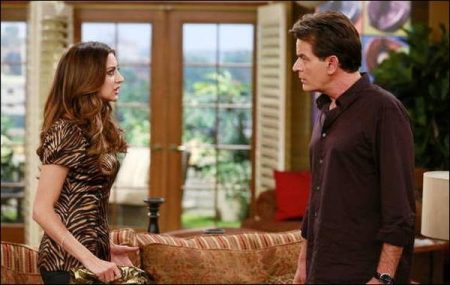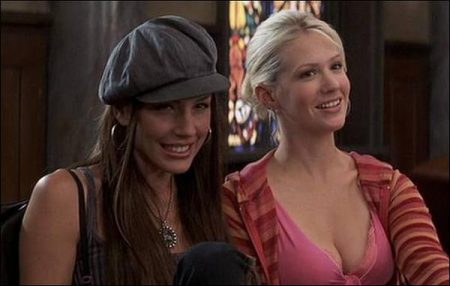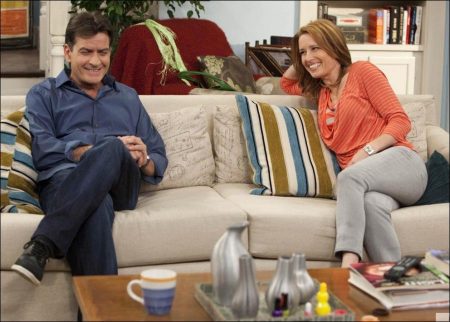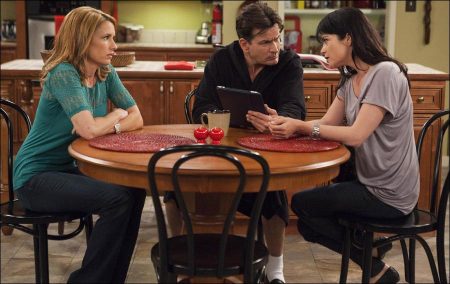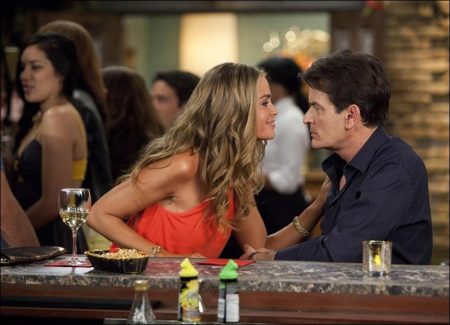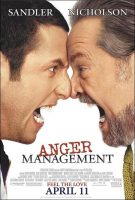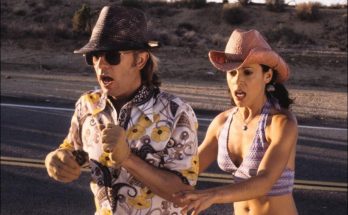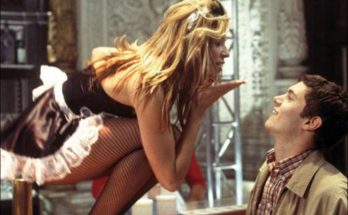Taglines: Let the healing begin.
After a misunderstanding aboard an airplane that escalates out of control, the mild-mannered Dave Buznik (Adam Sandler) is ordered by Judge Daniels (Lynne Thigpen) to attend anger management sessions run by Doctor Buddy Rydell (Jack Nicholson), which are filled with highly eccentric and volatile men and women. Buddy’s unorthodox approach to therapy is confrontational and abrasive and Dave is bewildered by it. Then, after yet another mishap, Judge Daniels orders Dave to step up his therapy or wind up in jail. So, Buddy moves in with Dave to help him battle his inner demons.
Buddy himself has no inner demons since he acts out at every opportunity and that includes making lewd comments about Dave’s girlfriend Linda (Marisa Tomei) and goading Dave into confronting every slight, past or present, head-on. But Buddy finally goes too far and Dave must decide whether to crawl back into his shell or stand up for himself. Could it be that Buddy’s confounding and contradictory treatment is just what the doctor ordered?
Anger Management is a 2003 American slapstick comedy film directed by Peter Segal, written by David S. Dorfman, and starring Adam Sandler, Jack Nicholson, and Marisa Tomei. It was produced by Revolution Studios in association with Sandler’s production company Happy Madison Productions and was distributed by Columbia Pictures. When an annoying passenger, and a case of mistaken identity, causes Dave Buznik to lose his temper on an airline flight, he is sentenced to anger management classes. Buznik learns his therapist is the passenger, who proves to have a rather interventionist style of therapy.
About the Production
“What made the idea of Anger Management so funny to me,” says screenwriter David Dorfman, “was to start with the last guy in the world you’d ever think would need anger management and then pair him with a therapist who makes him angry.”
The true test of such a concept, he concedes, is whether the story can maintain the cleverness of its initial premise. The script for Anger Management passed that test, according to the film’s star and executive producer Adam Sandler. When Revolution Studios founder Joe Roth asked him to read the script, Sandler says he picked it up and “I immediately liked the title and knew I needed some in real life, so I figured I should at least take a look. Then I read it and I was laughing. And I just kept going and it didn’t let me down.”
The reason Dorfman’s screenplay worked so well, explains Revolution Studios partner Todd Garner, also an executive producer on the film, is that it used humor to get under the skin of a real issue and not merely for the sake of generating some good gags. “At its core, it’s about a man who’s having a tough time expressing himself and another man who comes into his life and helps him deal with that,” says Garner.
In his writing, Dorfman says he took care to make the therapy as unusual as the disease. “Doctor Buddy Rydell (Jack Nicholson) makes Dave (Sandler) do all the things he hates. He puts him through every possible comedic nightmare, which finally forces Dave to take action in order to survive. In the end Dave is cured, but in an unexpected way.”
Among the indignities Dave must suffer to rid himself of his pent-up anger are group sessions with a decidedly eccentric bunch of men and women who also suffer from anger control issues, confronting a childhood tormentor, being propositioned by a transvestite, singing “I Feel Pretty” on the Queensboro bridge during rush hour and shacking up with Doctor Buddy, who proves to be a demanding roommate.
“Doctor Buddy keeps pushing Dave’s buttons to see how long he can go without snapping,” says Sandler. “Basically he’s trying to get him to come out of his shell.”
“Buddy puts Dave through a series of tests,” says Anger Management director Peter Segal, “through which he confronts his demons and graduates to the next level. The reason Buddy exposes him to all things is to get him to overcome them and emerge a better person.”
Somehow this oddball treatment works and Dave’s life actually improves, though he’s never sure exactly how he got there, observes Garner. “The humor flows from an unorthodox vein,” says Garner, “but by the end, Dave really has broken through, which makes the story all the more satisfying.”
That undertow of reality, however skewed, brought energy to the film’s comedic possibilities, according to Segal. “The script really sucks you in because, when you start out, you don’t think there’s anything wrong with Dave Buznik (Sandler),” says Segal. “He seems innocent and trapped. He doesn’t seem to deserve his fate.”
But when anger management specialist Doctor Buddy Rydell (Jack Nicholson) enters Dave’s life, the story evolves in completely unexpected ways. “Buddy provokes Dave to get a reaction and, at first, you’re not sure that reaction emanates from Dave’s pent up anger or is being created by Buddy,”
Segal continues. “As you go along, however, you realize that when Buddy comments on Dave’s past he shows a great deal of insight. That’s when the story really started to get interesting for me, when I realized he wasn’t just badgering Dave to get a reaction. He was actually intuitive and really getting inside the guy’s head.”
The combination of a great premise and a skillful execution united Sandler and Segal and lured a third major talent, Oscar winner Jack Nicholson, to assume the role of Doctor Buddy Rydell.
Sandler had envisioned Nicholson for the role while he was reading the script because “I tried to imagine Buddy as someone who made me feel nervous at times and comfortable at other times, and I immediately thought of Jack,” he says. “As I continued reading and imagining Jack in the role, I laughed even harder, which made it more fun to read. And then, he actually said yes.”
“Jack brings legitimacy to the role to Doctor Buddy Rydell because, in his attention to detail, he sounds like a therapist and embodies Buddy’s philosophy,” says Segal. “But he also brings that menacing edge that is innately Jack, which plays against all the caring qualities you expect from a reputable therapist.”
Not only did Nicholson bring his persona and precise sense of character to bear on Doctor Buddy Rydell, he brought the same kind of attention to the overall structure of the story. “Jack was involved in helping us shape not only his character but providing ideas and jokes that made the whole film funnier,” says executive producer Allen Covert, who also portrays Andrew, Dave’s rival for the affections of his girlfriend Linda (Marisa Tomei).
Nicholson’s suggestions gave the comedy additional resonance, says Sandler. “The audience laughs at the funny stuff, but they also laugh when the story fools them, when it shakes them up.”
Coming from two distinct disciplines, the mesh between Sandler and Nicholson proved to be ideal. “There was an immediate chemistry between them,” says Covert.
“The combo of the concept and the casting is a dream come true,” says Segal. “Anytime I describe Anger Management – ‘It’s a comedy about a guy played by Adam Sandler who has to take anger management classes. And Jack Nicholson is the therapist,’ – the reaction is immediate. Everyone says the same thing: ‘I’m there.’”
For Segal, the blend of Sandler and Nicholson’s distinct approaches toward character proved to be the best of both worlds. “Adam likes to experiment on the set. If things are going well, he tries something different to see if he can make it even better. If things aren’t working, he doesn’t leave until they do. It was fun to keep the camera rolling at times with Adam just so he could try different things.”
And how exactly did Nicholson approach Doctor Buddy? “One thing we talked about was bringing an off-balance sense to the audience’s perception of Buddy,” says Segal, “so they’d constantly be asking themselves if he is really a good therapist or maybe a bit insane and dangerous. The more he kept the audience guessing, the better he thought the story would be.”
The other benefit of combining two distinct talents like Sandler and Nicholson, according to Covert, is that it draws other top-flight performers to the project as well. For the pivotal role of Sandler’s girlfriend Linda, another Oscar® winner, Marisa Tomei, came aboard.
“The thing that was so wonderful about Marisa playing Linda was her natural ability to make things seem real, like we were a couple who already had a history,” says Sandler.
It’s through Linda’s character that the audience sees the first symptoms of Dave’s problems. “Dave is a really nice guy, almost a little too nice,” says Tomei. “He’s also very uncomfortable demonstrating any affection for me in public, even to say goodbye. Instead of kissing me, he shakes my hand.”
“Linda’s a nice girl and they’re really in love,” explains Sandler. “But he’s afraid to move to the next level because he thinks he’s not worthy of her and that she’s disappointed in him because he’s made no advancement in his career. I think he constantly wonders if she’s going to leave him.”
Not helping matters is the character of Andrew (Covert), who preys on Dave’s outward passivity and fear of confrontation by always hanging around with Linda, his ex-girlfriend from college days. “I’m this rich dilettante who is stuck on Linda,” explains Covert, “but I’m not aggressive about it. I’m just there to show that there are other alternatives.”
“Dave pretends that he’s okay with Linda seeing Andrew as a friend, but it eats him up inside,” says Sandler. “Like other people, Andrew senses that weakness and takes advantage of it.”
John Turturro, who had co-starred with Sandler in the hit comedy Mr. Deeds, was cast in the role of Chuck, one of the more explosive members of the anger management therapy group, and a man who is in every way Dave’s opposite. “Chuck is probably the biggest nightmare of the class,” says Sandler, “a man who is completely and totally in touch with his anger.”
Doctor Buddy pairs Chuck and Dave as partners outside of class, which leads to comic mayhem. Again the combination of the two talents clicked, according to Segal. “As they showed in Mr. Deeds, John and Adam’s energies play well off one another. John is very collaborative, very inventive, very intense. And as with Adam, we’d do a series of takes and just leave the cameras rolling.”
Rounding out the cast is a group of actors with proven comic ability, says Covert – former SNL vet Kevin Nealon (as Dave’s delightfully inept attorney), Luis Guzman (as a flamboyant member of the anger management group), recent Oscar nominee John C. Reilly (as Arnie Shankman, Dave’s childhood bully tormentor turned Buddhist monk), Woody Harrelson (as the transvestite Galaxia) and Heather Graham (playing a beautiful woman Dave tries to pick up). “All these guys have done comedy, and they get comedy,” observes Covert. “They can all work on the fly.”
And even some of the film’s cameo players like former New York mayor Rudolph Giuliani and Indiana University’s legendary coach Bobby Knight, managed to get into the film’s antic spirit. “I didn’t even know that Bobby Knight was a funny guy,” Covert confesses. “When I asked his wife she said, ‘oh yeah, that’s why I married him.’”
In preparation for directing the film, director Segal attended several anger management classes. “While it’s a comedy, I wanted the film to accurately reflect the kinds of treatment used for people with anger problems,” says Segal. “I wanted to have fun telling the story and at the same time make sure we didn’t disrespect the subject.”
While listening to the therapist list the symptoms of this kind of dysfunctional behavior, Segal suddenly realized to his dismay, “that I had nine or ten of them,” he laughs, “things from pent-up hostility while sitting in traffic, to not telling people how you really feel.”
Lending authenticity to Sandler’s passive, cool-on-the-outside character, Segal took his cue from one particular woman, whom he describes as “the sweetest girl on the outside and a real psycho on the inside. When she talked about why she had been ordered to come to these classes, you realized that she belonged there. She appears calm and controlled, but in a moment she can snap. As she said, ‘I’d go from happy to angry and I’d skip sad.’”
Anger Management was shot in New York and Los Angeles, and while on location in the east, director Segal made sure to use some of New York City’s most notable landmarks for some of the film’s most memorable moments. A scene between Dave and Buddy driving to work was moved to the Queensboro Bridge, which connects Queens with Manhattan (and is the basis for Simon & Garfunkel’s famous “59th Street Bridge Song,” aka “Feeling Groovy”). “I just thought it would give the scene more visual interest and tension to have Dave and Buddy stop in the middle of the bridge during rush hour to sing “I Feel Pretty,” (one of Doctor Buddy’s unconventional relaxation techniques).
When the production contacted the New York City film commission, however, their shooting opportunities on the bridge were seriously limited. “We could film at the crack of dawn on a Sunday morning and because of scheduling conflicts, neither Adam nor Jack was available.”
A second unit was sent to shoot the exteriors with doubles in the car, while back in Los Angeles on a soundstage, with a blue screen backdrop, Segal worked with Nicholson and Sandler. “It actually turned out much better,” Segal recalls. “It’s difficult to get a singing performance out of two actors when there’s traffic backed up behind them halfway through Queens.”
There were even greater limitations in using Yankee Stadium for the film’s climactic scene, Segal explains. The fictitious Yankees-Red Sox game would normally be sold out, but bringing in 50,000 was impractical both for time and budgetary considerations. “We used about 3,500 extras and 1,200 cardboard cut-outs,” says Segal, “the rest was the work of Sony Imageworks.”
Sony’s special effects division used “wire frames,” computerized skeletons of human forms that were then convincingly fleshed out to resemble a stadium full of baseball fans.
After that, the film’s final scene, which takes place in Central Park, would seem to be a cakewalk. But even Sony Pictures Imageworks couldn’t do anything about the scorching 95-degree heat wave that had gripped Manhattan and the loyal but persistent fans that crowded around, limiting Segal’s camera angles. “We went through all the duplicates of the costumes for the scene,” says Segal. “As soon as the actors put them on they were drenched. It was a very simple scene, but Jack and Adam will tell you they probably lost about twelve pounds shooting it.”
Anger Management (2003)
Directed by: Peter Segal
Starring: Adam Sandler, Jack Nicholson, Marisa Tomei, Luis Guzman, Michelle Rodriguez, Woody Harrelson, John Turturro, Lynne Thigpen, Krista Allen, January Jones
Screenplay by: David Dorfman
Production Design by: Alan Au
Cinematography by: Donald McAlpine
Film Editing by: Jeff Gourson
Costume Design by: Ellen Lutter
Set Decoration by: Chris L. Spellman
Music by: Teddy Castellucci
MPAA Rating: PG-13 on appeal for crude sexual content and language.
Distributed by: Revolution Studios
Release Date: April 11, 2003
Visits: 96
